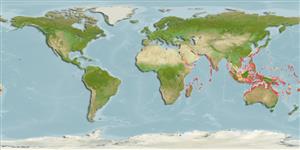Hexacorallia |
Scleractinia |
Poritidae
Environment: milieu / climate zone / пределы глубины / distribution range
экология
ассоциированный с рифами; пределы глубины 2 - 27 m (ссылка 107466). Tropical
Indo-West Pacific.
Length at first maturity / Size / Weight / Возраст
половая зрелость: Lm ? range ? - ? cm
Colony: flat or undulating plates. Corallites: septal spines usually regularly tapered. Polyps: short with knob-like tentacle tips. Color: pale pinkish-brown to bright pink, occasionally with grey oral discs and white tentacle tips (Ref. 848).
Found on shallow reef environments (Ref. 848).
Life cycle and mating behavior
половая зрелость | размножение | нерест | Eggs | Fecundity | Larvae
Members of the class Anthozoa are either gonochoric or hermaphroditic. Mature gametes are shed into the coelenteron and spawned through the mouth. Life cycle: The zygote develops into a planktonic planula larva. Metamorphosis begins with early morphogenesis of tentacles, septa and pharynx before larval settlement on the aboral end.
Основная ссылка
ссылки | координатор | соавторы
Veron, J.E.N. and G. Hodgson 1989 Annotated checklist of the hermatypic corals of the Philippines. Pacific Science 43:234-287. (ссылка 8817)
Статус Красного Списка МСОП
(ссылка 130435: Version 2025-1)
Статус СИТЕС (ссылка 108899)
CMS (ссылка 116361)
Not Evaluated
Угроза для людей
Использование человеком
| FishSource |
инструменты
дополнительная информация
Trophic EcologyFood items (preys)
состав пищи
потребление пищи
хищники
Population dynamicsрост
Max. ages / sizes
Length-weight rel.
Length-length rel.
Размерный состав
Mass conversion
численность
Life cycleразмножениеполовая зрелостьFecundityнерестEggsРазвитие икрыLarvae PhysiologyOxygen consumption
Human RelatedStamps, coins, misc.
ресурсы в Интернет
Estimates based on models
Preferred temperature
(Ref.
115969): 23.6 - 29.3, mean 27.8 (based on 2132 cells).
Категория цены
Unknown.
